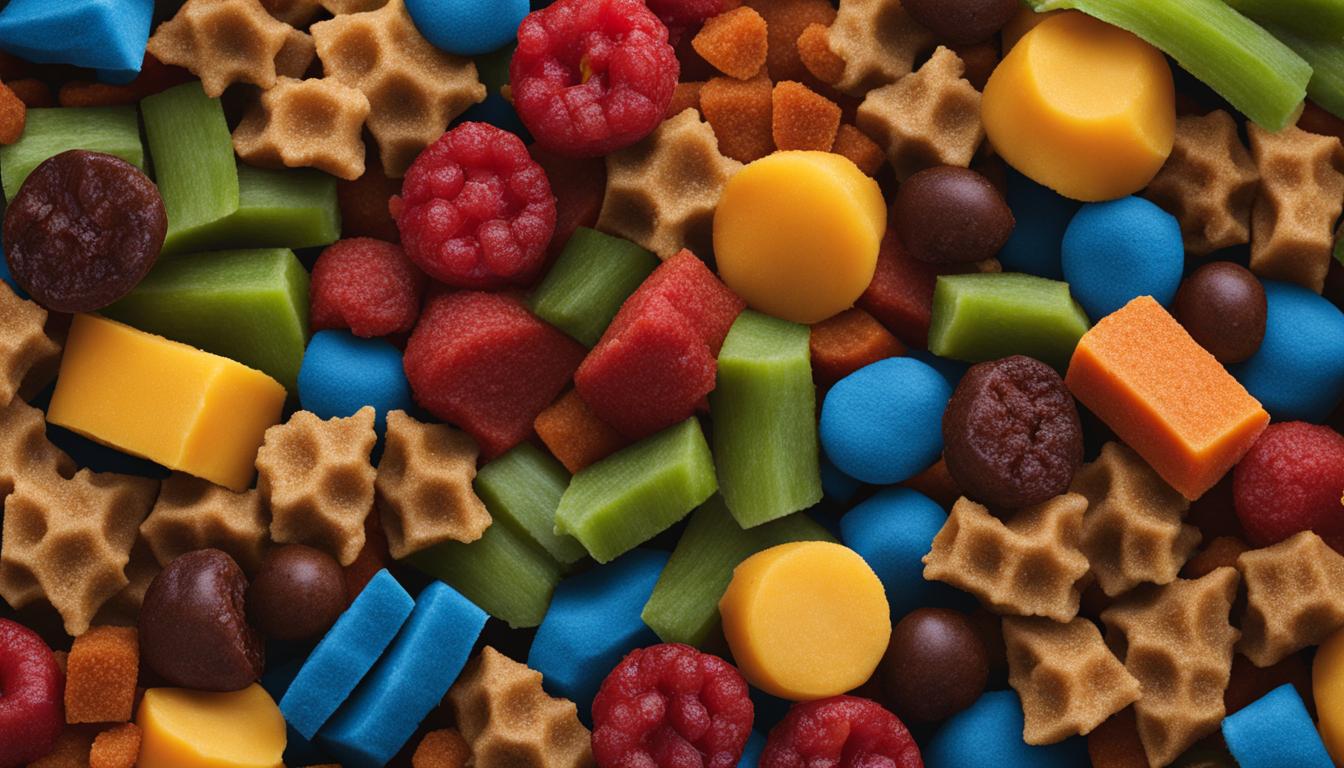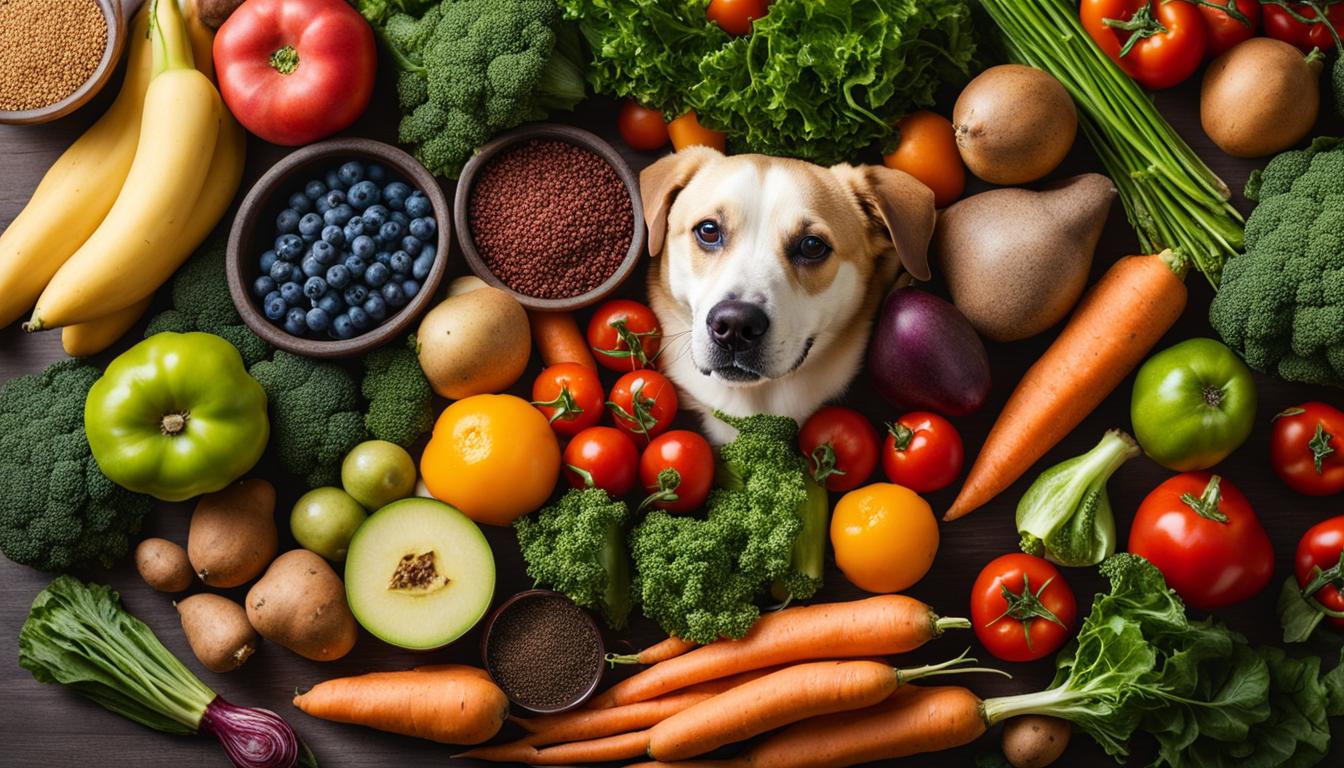When it comes to feeding your furry friend, you probably focus on the brand, ingredients, and nutritional value of their food. But did you know that the texture of your dog’s food also plays a crucial role in their eating habits and overall health? It’s true! Food texture can impact palatability, digestion, and even dental health in dogs.
So, why is food texture important for dogs? Let’s dig deeper and explore how different textures, such as soft, hard, crunchy, or wet, can affect your dog’s eating habits. Understanding the impact of food texture can help you make informed choices about what to put in your pup’s bowl.
Key Takeaways:
- Food texture plays a significant role in a dog’s eating habits and overall health.
- Texture can impact palatability, digestion, and dental health in dogs.
- Different textures, such as soft, hard, crunchy, or wet, can affect a dog’s preferences and satiety levels.
- Understanding the impact of food texture on dogs can help pet owners make informed choices about their furry friend’s diet.
- Choosing the right food texture for your dog’s specific needs is essential for their well-being.
The Role of Food Texture in Palatability for Dogs
When it comes to your dog’s dining experience, food texture plays a crucial role in palatability. Just like humans, dogs have taste preferences that are influenced by the texture of their food. Research has shown that textured dog food can significantly enhance the enjoyment of meals for our furry friends.
Different textures, such as crunchy, chewy, or a combination of both, can stimulate a dog’s senses and make mealtime more exciting. Imagine biting into a crispy apple or savoring the tenderness of a juicy steak – textures add layers of enjoyment to the overall taste experience. The same principle applies to our canine companions.
Offering a variety of textured food options can help keep your dog engaged and satisfied during mealtime. By incorporating kibble with different shapes, sizes, and textures into their diet, you can provide them with a range of flavors and textures to explore. This can also prevent mealtime boredom and ensure that their taste buds are continuously stimulated.
Emphasizing the importance of food texture, Dr. Jane, a renowned veterinary nutritionist, highlights, “Texture can have a significant impact on a dog’s eating experience. By introducing different textures, we can enhance palatability and promote a healthy appetite.”
The Benefits of Textured Dog Food
Textured dog food offers numerous benefits beyond palatability. It can help improve oral health by promoting chewing, which aids in reducing plaque and tartar buildup. The act of chewing textured food also supports proper jaw development and can be particularly beneficial for puppies and senior dogs.
Additionally, textured food can contribute to a dog’s overall well-being by promoting a healthy digestive system. The combination of soft and crunchy textures stimulates the production of saliva and promotes proper digestion. Fiber-rich textures, such as those found in certain fruits and vegetables, can aid in regular bowel movements and prevent digestive issues.
When choosing textured food for your dog, it’s essential to consider their specific needs, preferences, and any dietary restrictions they may have. Consulting with your veterinarian can help you determine the best options for your furry companion.
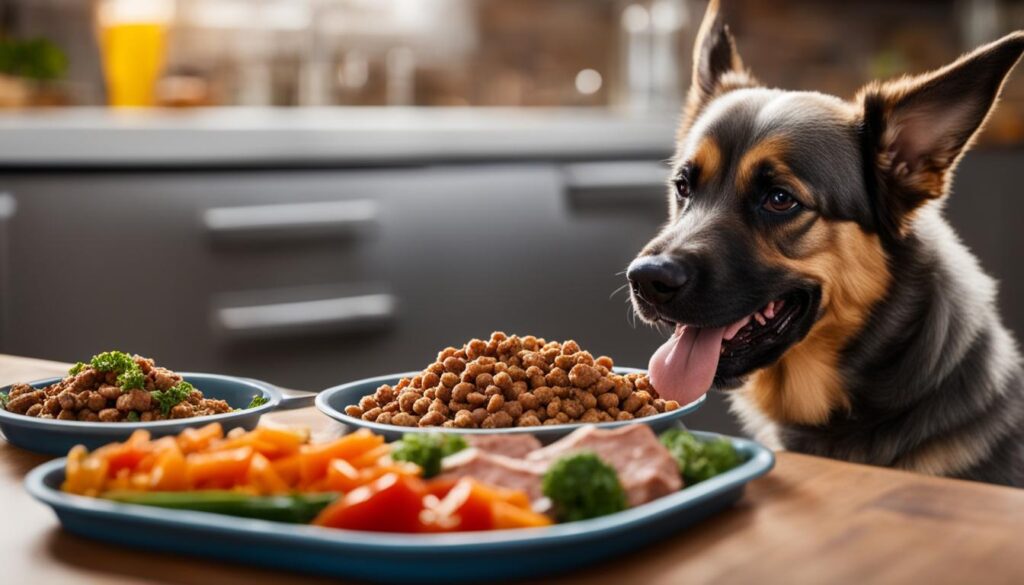
| Benefits of Textured Dog Food |
|---|
| Promotes dental health by reducing plaque and tartar buildup |
| Supports proper jaw development, especially in puppies and senior dogs |
| Stimulates saliva production for improved digestion |
| Aids in regular bowel movements and prevents digestive issues |
The Impact of Food Texture on Digestion in Dogs
When it comes to canine digestion, food texture plays a crucial role. Dogs have different chewing abilities, and the texture of their food can significantly impact how well they can break it down and digest it. This is especially important for senior dogs who may have dental issues or weaker jaw strength.
Textured food, such as kibble with varying shapes and sizes, can help promote proper digestion in dogs. The act of chewing on textured food encourages slower eating and stimulates saliva production, which aids in the breakdown of food. Additionally, some textures, like fiber-rich foods, can help maintain regular bowel movements and prevent digestive issues.
For senior dogs, choosing textured food that is easier to chew and digest is essential. Softening dry kibble with warm water or opting for wet food can also be beneficial. It’s important to consider your dog’s specific needs and consult with your veterinarian to determine the best food texture for their digestive health.
Table: Comparing Food Textures for Canine Digestion
| Food Texture | Advantages | Considerations |
|---|---|---|
| Crunchy (dry kibble) | Promotes dental health, stimulates chewing | Can be difficult to chew for senior dogs or those with dental issues |
| Soft (wet food) | Easier to chew and digest | May not provide the same dental benefits as crunchy food |
| Mixed textures | Can provide a balance of palatability and digestion benefits | May require experimentation to find the right balance for your dog |
Understanding the impact of food texture on digestion in dogs can help ensure their overall digestive health. By selecting appropriate textured food that meets your dog’s specific needs, you can help support their digestion and overall well-being.
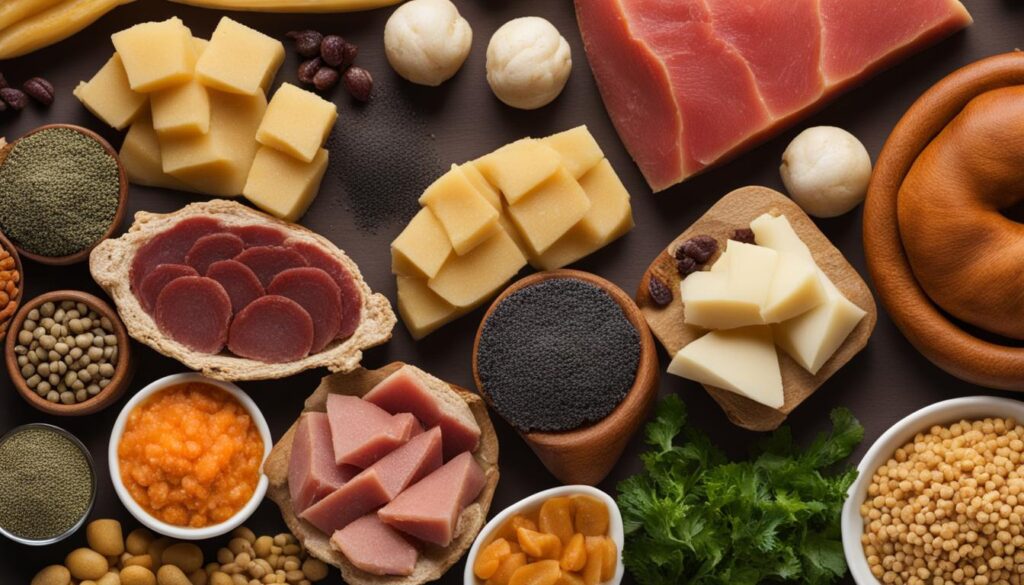
The Connection Between Food Texture and Dental Health in Dogs
When it comes to keeping your dog’s teeth clean and healthy, the texture of their food plays a crucial role. Chewing on textured food, such as kibble, can help remove plaque and tartar buildup on their teeth, reducing the risk of dental issues like gum disease and tooth decay. The size and texture of the kibble are important factors in promoting dental hygiene.
Textured food provides a mechanical cleaning action as your dog chews, helping to scrub away debris and prevent the formation of dental plaque. The act of chewing also stimulates saliva production, which can neutralize acids and fight against harmful bacteria in the mouth. By including appropriate textured food and treats in your dog’s diet, you can support their dental health and overall well-being.
“Textured food provides a mechanical cleaning action as your dog chews, helping to scrub away debris and prevent the formation of dental plaque.”
Additionally, there are specially formulated textured treats available that specifically target dental care. These treats are designed to promote chewing and provide additional cleaning benefits. They often have a unique texture that helps remove plaque and tartar from hard-to-reach areas of your dog’s mouth.
Remember, dental health is essential for your dog’s overall health and longevity. Regular veterinary check-ups, professional cleanings, and a dental-friendly diet can all contribute to maintaining healthy teeth and gums. By paying attention to the texture of your dog’s food and providing them with appropriate dental care, you can help ensure they have a happy and healthy smile for years to come.
Choosing the Right Food Texture for Your Dog’s Specific Needs
When it comes to selecting the right food texture for your dog, there are a few factors to consider. Wet food and dry food each have their own advantages and disadvantages, and understanding your dog’s specific needs can help you make an informed decision.
For senior dogs or those with dental issues, wet food may be a better choice. The softer texture of wet food makes it easier to chew and can be gentler on their teeth and gums. Wet food also tends to have a stronger aroma and flavor, which can be appealing to picky eaters. However, it’s important to note that wet food can spoil more quickly and may not be as convenient for busy pet owners.
Dry food, on the other hand, offers a crunchy texture that can help maintain dental health. The act of chewing on dry kibble can help remove plaque and tartar buildup, promoting good oral hygiene. Dry food is also easier to store and can be left out for longer periods without spoiling. However, some dogs may find dry food less palatable and may require additional moisture in their diet.
When choosing the right food texture for your dog, it’s crucial to consider their age, dental condition, and taste preferences. Some dogs may have texture preferences, and offering a variety of textured food can help ensure they enjoy their meals. Whether you opt for wet food, dry food, or a combination of both, the key is to provide a balanced and nutritious diet that meets your dog’s individual needs.
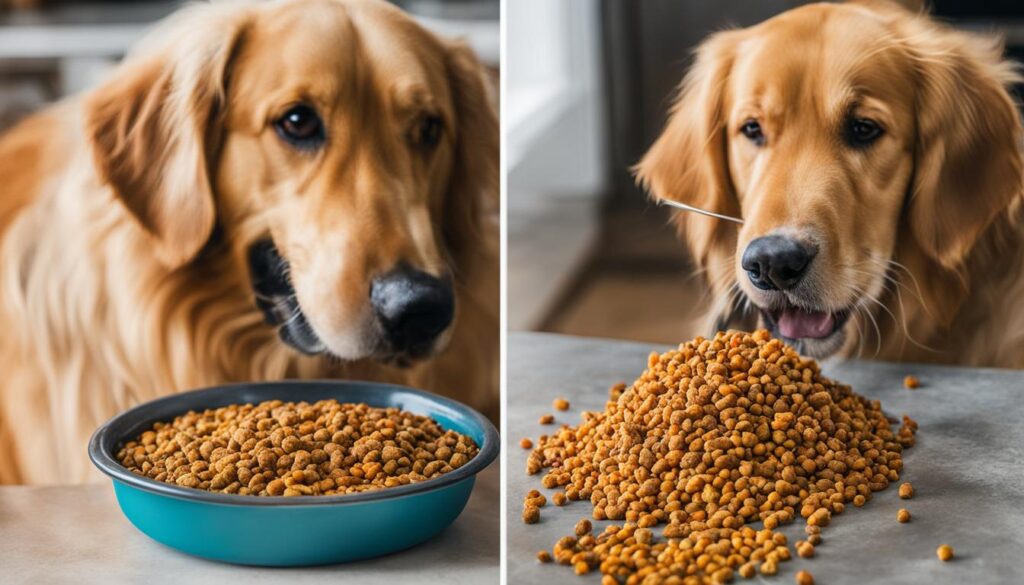
| Food Texture | Advantages | Disadvantages |
|---|---|---|
| Wet Food | – Easier to chew – Strong aroma and flavor – Suitable for senior dogs and those with dental issues |
– Spoils more quickly – Less convenient for storage and travel |
| Dry Food | – Crunchy texture promotes dental health – Convenient for storage and travel – Suitable for dogs with no dental issues |
– Some dogs find it less palatable – May require additional moisture |
The Science Behind Food Texture’s Impact on Dogs
Research plays a crucial role in understanding the impact of food texture on dogs. Scientific studies have delved into various aspects of canine food texture, providing valuable insights into its role in palatability, digestion, dental health, and overall nutrition.
A comprehensive study conducted by Dr. Emily Johnson at the Canine Nutrition Research Institute examined the sensory characteristics of dog food, including flavor, aroma, and texture. The study found that texture is a key factor influencing palatability for dogs. They discovered that dogs tend to prefer food with a combination of textures, such as crunchy and chewy, which stimulates their senses and enhances enjoyment of the meal.
According to Dr. Johnson, “Our research highlights the importance of texture in canine nutrition. Texture not only affects palatability but also plays a significant role in promoting proper digestion and maintaining dental health in dogs.”
Another scientific study conducted by the University of Veterinary Medicine in Vienna focused on the relationship between food texture and digestion in dogs. The study revealed that textured food, particularly for senior dogs, encourages chewing and slows down eating, promoting better digestion. Additionally, certain textures, like fiber-rich foods, can aid in regular bowel movements and prevent digestive issues.
The research conducted by Dr. Johnson and the University of Veterinary Medicine in Vienna underscores the significance of selecting appropriate food textures based on a dog’s individual needs and preferences. By understanding the science behind food texture’s impact on dogs, pet owners can make informed choices and provide their furry friends with a satisfying and nutritious dining experience.

Table: Studies on Food Texture and Dogs
| Study | Focus | Key Findings |
|---|---|---|
| Canine Nutrition Research Institute | Sensory characteristics of dog food | Texture influences palatability; dogs prefer a combination of textures, such as crunchy and chewy |
| University of Veterinary Medicine in Vienna | Relationship between food texture and digestion | Textured food promotes proper digestion, encourages chewing, and aids in regular bowel movements |
Conclusion
Food texture plays a crucial role in your dog’s eating habits and overall well-being. It can influence palatability, digestion, dental health, and even their enjoyment during mealtime. By understanding the impact of food texture on dogs, you can make informed decisions about their diet.
Different textures, such as soft, hard, crunchy, or wet, provide various benefits for your furry friend. Dogs have different taste preferences, so offering a variety of textured food can enhance their palatability and stimulate their senses. Textured food also promotes proper digestion by encouraging chewing and slowing down eating, especially for senior dogs.
When it comes to dental health, textured food like kibble can help remove plaque and tartar buildup, reducing the risk of dental issues. Choosing the right food texture for your dog’s specific needs, such as wet food for puppies or senior dogs with dental issues, is crucial for their overall well-being.
In conclusion, food texture’s impact on dogs cannot be underestimated. By considering factors like age, dental health, and taste preferences, you can ensure that your dog enjoys a satisfying and nutritious dining experience. So, the next time you choose dog food, remember to think about the texture to keep your furry friend happy and healthy!
FAQ
How does food texture impact dogs’ eating habits?
Food texture can significantly influence a dog’s eating habits, including their enjoyment of food and satiety levels.
What is the role of food texture in palatability for dogs?
Textured dog food, such as kibble with different shapes and sizes, can enhance palatability and stimulate a dog’s senses.
How does food texture impact digestion in dogs?
Textured food promotes proper digestion by encouraging chewing and slowing down eating, especially for senior dogs.
What is the connection between food texture and dental health in dogs?
Chewing on textured food, like kibble, helps remove plaque and tartar buildup, reducing the risk of dental issues.
How do I choose the right food texture for my dog’s specific needs?
Consider factors such as age, dental health, and taste preferences when selecting the appropriate food texture for your dog.
What scientific studies have been conducted on food texture’s impact on dogs?
Various scientific studies have explored the influence of food texture on palatability, digestion, dental health, and overall nutrition in dogs.

